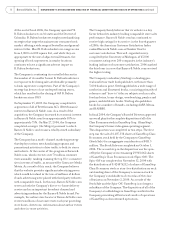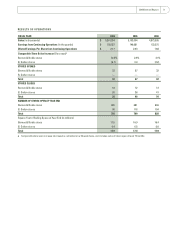Barnes and Noble 2006 Annual Report Download - page 20
Download and view the complete annual report
Please find page 20 of the 2006 Barnes and Noble annual report below. You can navigate through the pages in the report by either clicking on the pages listed below, or by using the keyword search tool below to find specific information within the annual report.
Off-Balance Sheet Arrangements
As of February , , the Company had no off -
balance sheet arrangements as defi ned in Item of
the Regulation S-K.
Impact of Infl ation
The Company does not believe that infl ation has had a
material eff ect on its net sales or results of operations.
CERTAIN RELATIONSHIPS AND RELATED
TRANSACTIONS
See Note to the Notes to Consolidated Financial
Statements.
CRITICAL ACCOUNTING POLICIES
Management’s Discussion and Analysis of Financial
Condition and Results of Operations discusses the
Company’s consolidated fi nancial statements, which
have been prepared in accordance with accounting
principles generally accepted in the United States.
The preparation of these fi nancial statements require
management to make estimates and assumptions in
certain circumstances that aff ect amounts reported in
the accompanying consolidated fi nancial statements and
related footnotes. In preparing these fi nancial state-
ments, management has made its best estimates and
judgments of certain amounts included in the fi nancial
statements, giving due consideration to materiality. The
Company does not believe there is a great likelihood that
materially diff erent amounts would be reported related
to the accounting policies described below. However,
application of these accounting policies involves the
exercise of judgment and use of assumptions as to future
uncertainties and, as a result, actual results could diff er
from these estimates.
Merchandise Inventories
Merchandise inventories are stated at the lower of cost
or market. Cost is determined primarily by the retail
inventory method on the fi rst-in, fi rst-out (FIFO)
basis for and of the Company’s merchandise
inventories as of February , and January , ,
respectively. The remaining merchandise inventories
are recorded based on the average cost method.
Market is determined based on the estimated net
realizable value, which is generally the selling price.
Reserves for non-returnable inventory are based on
the Company’s history of liquidating non-returnable
inventory.
The Company also estimates and accrues shortage for
the period between the last physical count of inventory
and the balance sheet date. Shortage rates are estimated
and accrued based on historical rates and can be aff ected
by changes in merchandise mix and changes in actual
shortage trends.
Stock-Based Compensation
Eff ective January , , the Company adopted
the provisions of Statement of Financial Accounting
Standard (SFAS) No. R, “Share-Based Payment”
(SFAS R), using the modifi ed prospective transition
method. Under this transition method, stock-based
compensation expense recognized for share-based
awards during fi scal includes (a) compensa-
tion expense for all stock-based compensation awards
granted prior to, but not yet vested as of, January ,
, based on the grant date fair value estimated in
accordance with the original provisions of SFAS ,
revised to estimate forfeitures, and (b) compensa-
tion expense for all stock-based compensation awards
granted subsequent to January , , based on the
grant date fair value estimated in accordance with the
provisions of SFAS R. In accordance with the modi-
fi ed prospective transition method, results for the prior
period have not been restated. Prior to the adoption
of SFAS R, the Company recognized stock-based
compensation expense in accordance with APB and
related Interpretations, as permitted by SFAS .
The calculation of share-based employee compensation
expense involves estimates that require management’s
judgment. These estimates include the fair value of
each of the stock option awards granted, which is
estimated on the date of grant using a Black-Scholes
option pricing model. There are two signifi cant inputs
into the Black-Scholes option pricing model: expected
volatility and expected term. The Company estimates
expected volatility based on traded option volatility of
the Company’s stock over a term equal to the expected
term of the option granted. The expected term of stock
option awards granted is derived from historical exercise
experience under the Company’s stock option plans and
18 Barnes & Noble, Inc. MANAGEMENT’S DISCUSSION AND ANALYSIS OF FINANCIAL CONDITION AND RESULTS OF OPERATIONS continued
























